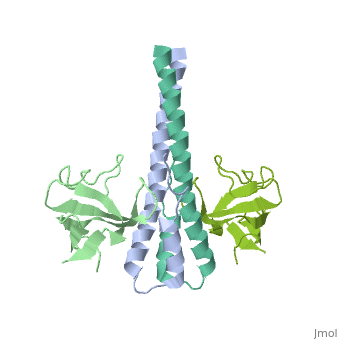2hkq: Difference between revisions
Jump to navigation
Jump to search
No edit summary |
No edit summary |
||
| (13 intermediate revisions by the same user not shown) | |||
| Line 1: | Line 1: | ||
==Crystal structure of the C-terminal domain of human EB1 in complex with the CAP-Gly domain of human Dynactin-1 (p150-Glued)== | |||
<StructureSection load='2hkq' size='340' side='right'caption='[[2hkq]], [[Resolution|resolution]] 1.86Å' scene=''> | |||
== Structural highlights == | |||
<table><tr><td colspan='2'>[[2hkq]] is a 2 chain structure with sequence from [https://en.wikipedia.org/wiki/Homo_sapiens Homo sapiens]. Full crystallographic information is available from [http://oca.weizmann.ac.il/oca-bin/ocashort?id=2HKQ OCA]. For a <b>guided tour on the structure components</b> use [https://proteopedia.org/fgij/fg.htm?mol=2HKQ FirstGlance]. <br> | |||
</td></tr><tr id='method'><td class="sblockLbl"><b>[[Empirical_models|Method:]]</b></td><td class="sblockDat" id="methodDat">X-ray diffraction, [[Resolution|Resolution]] 1.86Å</td></tr> | |||
<tr id='resources'><td class="sblockLbl"><b>Resources:</b></td><td class="sblockDat"><span class='plainlinks'>[https://proteopedia.org/fgij/fg.htm?mol=2hkq FirstGlance], [http://oca.weizmann.ac.il/oca-bin/ocaids?id=2hkq OCA], [https://pdbe.org/2hkq PDBe], [https://www.rcsb.org/pdb/explore.do?structureId=2hkq RCSB], [https://www.ebi.ac.uk/pdbsum/2hkq PDBsum], [https://prosat.h-its.org/prosat/prosatexe?pdbcode=2hkq ProSAT]</span></td></tr> | |||
</table> | |||
== Function == | |||
[https://www.uniprot.org/uniprot/MARE1_HUMAN MARE1_HUMAN] Binds to the plus end of microtubules and regulates the dynamics of the microtubule cytoskeleton. Promotes cytoplasmic microtubule nucleation and elongation. May be involved in spindle function by stabilizing microtubules and anchoring them at centrosomes. May play a role in cell migration.<ref>PMID:12388762</ref> <ref>PMID:21646404</ref> <ref>PMID:16109370</ref> <ref>PMID:19632184</ref> | |||
== Evolutionary Conservation == | |||
[[Image:Consurf_key_small.gif|200px|right]] | |||
Check<jmol> | |||
<jmolCheckbox> | |||
<scriptWhenChecked>; select protein; define ~consurf_to_do selected; consurf_initial_scene = true; script "/wiki/ConSurf/hk/2hkq_consurf.spt"</scriptWhenChecked> | |||
<scriptWhenUnchecked>script /wiki/extensions/Proteopedia/spt/initialview01.spt</scriptWhenUnchecked> | |||
<text>to colour the structure by Evolutionary Conservation</text> | |||
</jmolCheckbox> | |||
</jmol>, as determined by [http://consurfdb.tau.ac.il/ ConSurfDB]. You may read the [[Conservation%2C_Evolutionary|explanation]] of the method and the full data available from [http://bental.tau.ac.il/new_ConSurfDB/main_output.php?pdb_ID=2hkq ConSurf]. | |||
<div style="clear:both"></div> | |||
==See Also== | |||
*[[Dynactin|Dynactin]] | |||
*[[End-binding protein|End-binding protein]] | |||
*[[Microtubule-associated protein 3D structures|Microtubule-associated protein 3D structures]] | |||
== References == | |||
<references/> | |||
== | __TOC__ | ||
</StructureSection> | |||
== | |||
[[Category: Homo sapiens]] | [[Category: Homo sapiens]] | ||
[[Category: | [[Category: Large Structures]] | ||
[[Category: Honnappa | [[Category: Honnappa S]] | ||
[[Category: Steinmetz | [[Category: Steinmetz MO]] | ||
[[Category: Winkler | [[Category: Winkler FK]] | ||
Latest revision as of 12:33, 14 February 2024
Crystal structure of the C-terminal domain of human EB1 in complex with the CAP-Gly domain of human Dynactin-1 (p150-Glued)Crystal structure of the C-terminal domain of human EB1 in complex with the CAP-Gly domain of human Dynactin-1 (p150-Glued)
Structural highlights
FunctionMARE1_HUMAN Binds to the plus end of microtubules and regulates the dynamics of the microtubule cytoskeleton. Promotes cytoplasmic microtubule nucleation and elongation. May be involved in spindle function by stabilizing microtubules and anchoring them at centrosomes. May play a role in cell migration.[1] [2] [3] [4] Evolutionary Conservation Check, as determined by ConSurfDB. You may read the explanation of the method and the full data available from ConSurf. See AlsoReferences
|
| ||||||||||||||||
